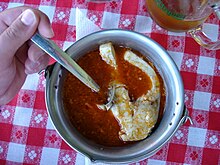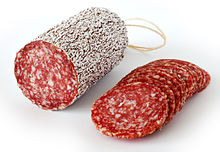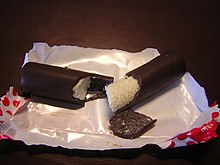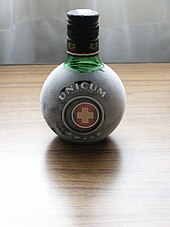Hungarian cuisine
The Hungarian cuisine is the national cuisine of Hungary . She is best known for goulash soup (gulyás), goulash ( stew ), Paprikás , paprika chicken (paprikás csirke) Tokány , Esterházy cake and Hungarian salami .

background
Historically, Hungarian cuisine is based on traditional rural cuisine and the magnate cuisine of the Hungarian nobility. As in all of Eastern Europe, real home-style cooking was not developed until the 19th century. Mörhing goes so far as to generally view smaller national kitchens as constructions of the 19th century. In the case of Hungarian cuisine, this goes back to the (nationalistic) efforts of the Hungarian nobility at the time, but it cannot be sharply separated from the superior, culinary empires, i.e. the Ottoman and Viennese court kitchens. In the post-war gastronomy in Germany in particular, the separation from the Balkan cuisine was not carried out clearly, even in individual restaurants. In Yugoslav and Croatian restaurants, the close relationship with Austria-Hungary was and is in some cases also portrayed in culinary terms , and the fashion of the Balkan grills at the time was also linked to Puszza or Hungarian grills.
Features of Hungarian cuisine
A number of products reflect the geographical and cultural diversity of the country, which is culinary characterized by grazing and fruit and vegetable cultivation. Hungary has always had wine-growing regions with products such as Tokaj and white wines from the area around Lake Balaton. This is also used for fishing, for instance for the Fogasch (fogas, so Zander from the Balaton), which is a popular food fish in Hungary, either fried or fish stew.
For Hungary's tradition of baking and confectionary among others, the witness pancakes , the Esterházy cake , the Dobos cake , Gerbaudschnitten ( Zserbó-szelet ) or Somló dumplings ( Somlói galuska ).
Paprika (fresh, powdered or pureed) and sour cream ( tejföl ) play a central role in Hungarian cuisine and are used to season and taste a variety of dishes. The traditional cooking utensil is the kettle ( bogrács ), usually made of copper. In it, many dishes were prepared on an open fire, such as kettle goulash or fish soup ( halászlé ). In the 20th century, the chef Karl Gundel was the most influential in the style of Hungarian cuisine.
The most important food names are:
- Előételek (starters)
- Levesek (soups)
- Saláták (salads)
- Készételek ("ready-made meals", meaning dishes that are not freshly prepared after ordering (e.g. pörkölt ))
- Frissensültek (freshly fried, e.g. " Wiener Schnitzel " ( Bécsi szelet ))
- Halételek or Halak (fish dishes)
- Szárnyasok (poultry)
- Tészták (pasta)
- Sütemények ( desserts )
- Sajtok (cheese)
Dishes and products
meat and fish
-
Goulash (by gulyás the Hungarians understand goulash soup )
- Bográcsgulyás (The "original form", the kettle goulash )
- Pörkölt (in terms of consistency comparable to the goulash known in German-speaking countries, clearly different in taste)
- Paprika
- Halászlé (spicy fish soup , in Hungary a "question of faith", which version is the better)
- Hurka (véres hurka: blood sausage, májas hurka: liver sausage , homemade pork specialties, hurka and kolbász together are called disznótoros )
- Fatánýeros grill plate
- Fogasch (Hungarian: "fogas" , pikeperch - the basis of many dishes)
- Libamáj ( foie gras )
- Hortobágy pancakes (goulash-based filling)
- Debrecziner (named after the city of Debrecen ) lightly smoked sausage with sweet, sweet pepper
- Kolbász (spicy paprika sausages , especially famous: csabai, gyulai)
- Korhely soup (goulash soup with sauerkraut)
- Pandúrrostbraten (see Pandur , police or personal servants of nobles)
- Paprika chicken (Hungarian: "Paprikás Csirke" , in the knapsack of the rich man after Károly Gundel)
- Tokany
- téliszálami winter salami
Side dishes and miscellaneous
- Bableves ( bean soup )
- Lángos (deep-fried yeast dough cakes seasoned with garlic, optionally with cheese and / or sour cream)
- Paprika powder (e.g. rose paprika )
- Erős Pista , a spicy seasoning paste
- Sztrapacska ( dumplings with sheep's cheese, diced bacon and sour cream)
- Tarhonya (small pasta as a side dish)
- Csipetke small pasta for soups
- Lecsó (vegetable dish made from peppers, onions and tomatoes, usually with sausages)
- Túrós csusza / tészta tagliatelle with greens, lard, curd cheese and sour cream. The sweet version with icing sugar and sour cream is a popular children's dish.
- Kovászos uborka (pickled cucumbers ).
- Túrógombóc (curd dumplings or curd balls) is mainly served with sour cream.
Baked goods and desserts
- Strudel (Hungarian: "Rétes" )
- Pogatschen (Hungarian: "pogácsa" , small baked goods with cheese or greens or greaves, sometimes potatoes in the batter)
- zserbo or Gerbaud-szelet (layer cake with apricot jam-nut filling and chocolate icing)
- Dobos cake (layer cake with chocolate cream and icing)
- Esterházy cake
- Lúdláb ("goosefoot cake ")
- Rigó Jancsi piece of cake with chocolate cream
- Gesztenyepüré puree made from sweet chestnuts , similar to Swiss vermicelles
- Gyümölcsleves , a fruit soup made from cherries (meggyleves) or raspberries (málnaleves), sweet and sour entrée or dessert, usually cold
-
Pancakes (Hungarian: "palacsinta" , pancake / omelette as a sweet variant)
- Gundel palacsinta (with nut filling, from the famous Budapest restaurant Gundel )
- Meggyes palacsinta (with sour cherries)
- Rakott palacsinta (layered with jam)
- Túrós palacsinta (curd pancakes)
- Schomlauer Nockerl (Hungarian "Somlói Galuska" , from Somló ) Pieces of biscuit with rum, raisins, chocolate sauce, nuts and whipped cream
- "Chicken leg noodles" (deep-fried pastries with icing sugar)
- Kürtőskalács (Baumkuchen)
- Ziegler Käsetaler ( cheese waffles )
- Bejgli (poppy seed and nut rolls)
Dairy products
- Mackó cheese (cheese spread, similar to " La vache qui rit " , which comes from France and is also available in Germany )
- Túró Rudi (pieces of sweet curd cheese wrapped in chocolate in different flavors: natural, strawberry, etc.).
beverages
- Wines:
- Hungary is a traditional wine-growing country. The volcanic wine-growing areas at Lake Balaton are of Roman origin and around 2000 years old. The history of the Sopron wine regions in western Hungary and Eger and Tokaj in northeast Hungary goes back to the 13th century.
- Hungarian wines were mostly mass-produced during the communist period. Since the political change in Hungary in 1989, numerous investments and subsidies have been made for the renewal and quality reconstruction of Hungarian viticulture, so that an international quality standard has been achieved again in recent years. The best-known Hungarian wine is the Tokaj , which is increasingly being produced as a dry white wine . The southern Hungarian wine regions of Villány-Siklós and Szekszárd have made a name for themselves internationally with red wine in recent years. Red wine cuvées are also produced, the best-known being Egri Bikavér from north- east Hungarian Eger, which is made from at least four grape varieties.
Known regions:
- Erlauer red wine (Hungarian: "Egri bikavér" , also "bull's blood") and the white wine "Egri leányka" " Erlauer girls"
- Wines from the Villány region, southern Hungary
- from the Badacsony region Balaton-Oberland
- Mátra (around Gyöngyös) mostly strong country wines
- Sopron / Ödenburg good, mature red wines
- Barackpálinka or short barack (apricot, apricot brandy). The brand name for Hungaricum pálinka is protected and may only be used for high-quality original Hungarian products!
- Tokajer (Hungarian: "Tokaji" , fruity dessert wine)
- Zwack Unicum (herbal liqueur, digestif )
- Beer : Arany Ászok, Kőbányai, Dreher, Soproni Ászok, Borsodi
- Balfi, Visegrádi, Szentkirályi, Fonyódi, Margitszigeti, Theodora ( mineral water )
literature
- Anikó Gergely: Hungarian specialties. Könemann, Bonn 1999.
Web links
- Till Ehrlich : Swirled mixture - Hungarian cuisine beyond the paprika. In: taz . February 26, 2006.
swell
- ^ Joseph Wechsberg: The kitchen in the Viennese Empire. Time-Life International 1969, pp. 89-107.
- ^ Maren Möhring: Foreign food: The history of foreign gastronomy in the Federal Republic of Germany . Walter de Gruyter, 2012, ISBN 978-3-486-71779-2 , p. 325 ( google.de [accessed on January 7, 2017]).
- ^ Maren Möhring: Foreign food: The history of foreign gastronomy in the Federal Republic of Germany . Walter de Gruyter, 2012, ISBN 978-3-486-71779-2 , p. 322 ( google.de [accessed on January 7, 2017]).
- ↑ Jancis Robinson: The Oxford Wine Lexicon. Hallwag Verlag, Munich 2003, pp. 770-772.










